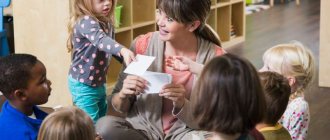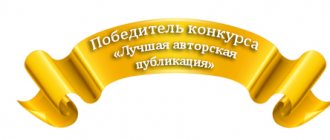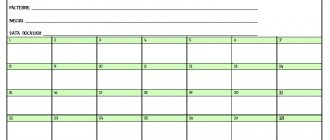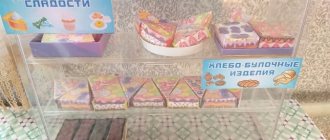Direct educational activities in preschool educational institutions according to the Federal State Educational Standard
Federal State Educational Standard is a federal state educational standard developed for the comprehensive development of the individual.
When drawing up a program for preschool institutions, the following are taken into account:
- individual capabilities and aspirations of the student;
- cooperation and desire for contact with adults;
- the nature of interaction with children and adults;
- respectful attitude towards peers and parents.
The Federal State Educational Standard controls that the educational process is indirect; both the student and the adult must be involved in learning.
Previous strictly regulated forms of education are becoming more flexible, meeting the capabilities and needs of children of primary, middle and senior preschool age.
The main goals that the Federal State Educational Standard faces when raising children in preschools:
- physical development;
- speech development;
- development of communication skills;
- personal development;
- development of motivation;
- development of socialization;
- development of cognitive interest;
- development of artistic skills and aesthetic taste.
Children of early preschool age implement the above skills through educational games with composite toys, physical exercises, experiments with various substances, household items, communication with peers and older children. Together with the teacher, musical works, paintings, fairy tales and poems are analyzed.
For children of senior preschool age, didactic games are role-playing in nature, preschoolers learn to follow rules and hierarchy, classes are exploratory in nature, self-service is taught, and household work skills are developed. Folklore, history, and fiction are studied in the lessons.
The modern educational system involves not only natural, paper and other application materials. Information technology products are also included, problem situations projected in a game format are considered and played out.
The task of the teacher in this case is to organize the educational process in such a way that the child develops comprehensively, intellectually, socially, and shows interest in the world around him and initiative in work activities.
Ways to organize children
All of the above problems are solved in various ways. Sometimes completely opposite approaches are taken for different children.
The following characteristics are taken into account in groups:
- a variety of toys and equipment in kindergarten;
- age characteristics of children;
- safety of indoor conditions;
- children's physical fitness level;
- teacher qualification level.
Physical exercises are taken as examples, but the process, goals, methods and teacher participation remain similar during educational lessons.
Frontal
The main goal of the pedagogical process is the acquisition and consolidation of children’s motor skills. They work actively and constantly interact with the teacher.
All movements are performed by children simultaneously and synchronously.
In large groups, it is difficult for an adult to pay attention to each student, and therefore improve the quality of movements.
Individual
Each exercise is performed alternately by children in a chain. While one does it, the rest observe and analyze.
The main advantage of the approach is the strict quality of execution. The main drawback is the passivity of other preschoolers. Effectively used at an older age to learn complex exercises.
In-line
To ensure high motor activity, children perform several exercises at once, in a circle, changing settings and equipment.
This is useful for developing endurance, but it is difficult for an adult to keep track of how each child performs the exercise correctly.
Group
Children are divided into several subgroups, where each performs their own task, after which they change. Useful for physical development and developing acceptance of responsibility for one’s actions.
In this method, the teacher has practically no opportunity to find and correct the student’s mistakes.
Teacher’s methodological cheat sheet “Structure of classes according to Federal State Educational Standards up to”
Elena Tarakina
Teacher’s methodological cheat sheet “Structure of classes according to Federal State Educational Standards up to”
Preparing the teacher for the lesson :
• Preparing a teacher for classes consists of three stages:
• Lesson ;
• Preparation of equipment;
• Preparing children for classes .
• Lesson :
• Select program content, outline methods and techniques , think through the course of the lesson .
• Make a plan - a summary, which includes:
• -program content (educational objectives)
;
• -equipment;
• -preliminary work with children (if necessary)
;
• - course of the lesson and methodological techniques .
•Equipment preparation:
• On the eve of the lesson , select the equipment, check whether it is in working order, whether there is enough teaching material, etc.
• Some activities require longer preliminary preparation (for example, if you need to show sprouted onions, they need to be sprouted in advance).
• When planning an excursion, the teacher must go to the site in advance, identify objects to observe, and think over the shortest and safest route.
• Preparing children for classes
• Creating interest in the upcoming work
• Warning children about the start of the lesson in advance (10 minutes in advance, so that the children have time to finish their games and get ready for the lesson
• Organizing the work of duty officers to prepare for the lesson
Lesson structure:
• The lesson includes three stages:
• 1. Organization of children;
• 2. Main part of the lesson ;
• 3. End of class .
•Organization of children:
– Checking children’s readiness for class (appearance, concentration)
;
– Creating motivation and interest in the lesson (techniques that contain entertainment, surprise, mystery)
.
•
• Main part of the lesson :
• Organization of children's attention;
• Explaining the material and showing the method of action or setting a learning task and joint solution (3-5 min)
;
• Consolidation of knowledge and skills (repetition and joint exercises, independent work with didactic material.
•
• End of class :
• Summing up (analysis together with the children of completed work, comparing the work with didactic tasks, assessing the children’s participation in the lesson , reporting what they will do next time);
• Switching children to another type of activity.
•
Threefold objective of the lesson :
•Educational: increase the level of child development
•Educational: to form the moral qualities of the individual, views and beliefs.
•Developing: when teaching, develop students’ cognitive interest, creativity, will, emotions, cognitive abilities - speech, memory, attention, imagination, perception.
Non-traditional activities :
Non-traditional form Contents
Lesson – creativity Verbal creativity of children using TRIZ technology “We compose fairy tales “inside out”
,
“Let’s invent a non-existent animal. Plant"
.
Lesson - gatherings Introducing preschoolers to children's folklore at traditional folk gatherings, which involve the integration of various types of activities.
Lesson - fairy tale Speech development of children in the framework of various types of activities, united by the plot of a fairy tale that is well known to them.
Lesson – press conference of journalists Children ask questions to the “astronaut”
, heroes of fairy tales and others, can be implemented through the project activity
“Young Journalists”
.
Lesson - travel Organized trip to your hometown, art gallery. The children themselves can act as guides.
Lesson - experiment Children experiment with paper, fabric, sand, snow.
Lesson - competition Preschoolers participate in competitions held by analogy with the popular television competitions KVN, “What? Where? When?"
,
“Smart Men and Smart Girls”
and others.
Lesson – drawings and essays
Children write fairy tales and stories based on their own drawings.
LESSON STRUCTURE:
• 1. Motivation.
The teacher is simply obliged to provide children with “freedom of choice”
upcoming activities and, at the same time, with your skill to captivate children with you.
For example, the teacher of the first junior group during an educational lesson told the children the fairy tale “Kolobok”
, and then offered motivation for the upcoming activity
(collective application of the character Kolobok)
“Guys, Kolobok ran away from his grandparents, they are crying bitterly. How can we help our grandparents? Then it offers possible answers: maybe we should draw a Kolobok and give it to our grandparents? Thus, she captivated the children, organized motivation for drawing, got them interested, and also solved the educational task: to make the children want to help their grandparents in finding Kolobok.
Features of work on creating gaming motivation for
different age stages:
Younger age - the motivation is in the material itself, so there is no point in inviting Dunno! Enough motivation! Each child has his own material - this is important! The material poses the challenge itself! The problem is to motivate them before they start acting on it themselves.
Middle group - you can bring a character because at this age children have already mastered the roles.
Senior group - (plots, plot composition)
– the main thing is not the characters, but the plots
(he handed over a letter, the character himself is not there, but there is a letter)
.
Plots can be long (travel in a time machine)
. In the course of direct educational activities, small paraphernalia, established roles, and changing roles can be used.
Preparatory group - games with rules, children ensure that the rules are followed. A competitive game with a winning mindset is used (chips are used)
. Give every child the opportunity to experience situations of winning and losing.
In the absence of motivation, there is no development of logic.
• 2. Rely on children's knowledge
Children are offered a game, a subject activity with dialogue, during which they remember what will help them get acquainted with a new topic (updating knowledge and skills)
.
• 3. Problem in the game situation
At the end of the game, a difficulty should arise, which the children record in speech. (Why couldn’t we? We don’t know this yet, we don’t know how.)
.
The teacher encourages them to ask questions and, together with the children, determines the topic of the upcoming activity. As a result, the children conclude that it is necessary to think about how everyone can get out of a difficult situation together (joint goal setting and planning)
.
For example, children need to help the Chicken find chickens. The teacher can ask : “Do you want to help the Hen find the chickens?
How can this be done? That is, the question is problematic in nature and forces children to think through answer options: call the chickens, go after them, etc.
• 4. Solving the problem. Discovering new knowledge or skill
The teacher , using introductory dialogue based on play activities, leads children to discover new knowledge or skills. Having formalized new knowledge or skill in speech, children return to the situation that caused the difficulty and overcome it using a new method of action.
• 5. Consolidating new things in a typical situation
At this stage, games are played where children use new knowledge or skills (a game situation is created that records each child’s individual mastery of new material).
• 6. Summary of GCD
Children record in their speech what new things they have learned, where new knowledge and skills will be useful. At the end of the ECD, the teacher sums up the results together with the children, involving the children in self-assessment (mutual assessment)
performance results.
Age stages of verification:
• Young age - when pointing out to a child a particular shortcoming in his activity, it is important to emphasize what inconveniences or difficulties this creates for the game character. (The child drew a house without windows; the teacher, on behalf of the bunny, can say that he is afraid to sit in the dark.) At this age, assessment occurs during the course of the educational activity itself, and not at the end. At the same time, comments and tips (how to fix)
should come not from
the teacher , but from the game character (the little bunny, not the teacher, asks the child to draw the windows in the house)
.
With children who completed the task before others, the teacher conducts individual conversations (on the educational and gaming content of the educational activity itself; it is advisable to structure the conversation as a conversation between two game characters, a little hare and a hare).
Middle age - the child learns to correlate the result obtained with the goal he has set and evaluate the work performed from the point of view of qualities that are significant to him.
By accepting a certain role and acting in it (in the role of a bunny, a child builds a house for himself), the child calmly accepts the teacher’s and does not react negatively to his failure. He treats criticism as a reminder to follow certain rules of the game that an adult plays with him. Thanks to this, children have a desire to finish the job they started and achieve results.
Older age – special attention should be paid to the formation of self-esteem and self-control. It is very important to organize the learning process so that every child achieves the desired result in any activity. Just like at a younger age, a child rejoices at success, and failure leads to confusion and refusal to work. The task of an adult is to teach children not to dramatize failures, but to treat them as a natural process. “He who does nothing makes no mistakes”
.
Teaching methods and techniques:
• 2nd junior group
• The lesson begins with elements of the game, surprise moments - the unexpected appearance of toys, the arrival of “guests”
etc. During
the lesson , gaming techniques and didactic games are used.
• Demonstration and handout material should be large. duration 10 minutes . The lesson is conducted in subgroups.
• Middle group
• Visual and effective teaching methods are used: the teacher examples and methods of action, children perform practical tasks, including elementary mathematical activities (establishing correspondence between the numbers of sets, counting, etc.)
Exploratory activities, such as tactile-motor examinations.
• Lesson duration 20 minutes . The lesson is conducted in subgroups.
• Senior group
• Visual, verbal and practical methods are used in combination. Five-year-old children are able to understand the cognitive task set by the teacher and act in accordance with his instructions. Setting a task awakens cognitive activity in children. (For example, “How do you know how much longer a table is than its width?”
)
• The types of visual aids are expanded, and their nature changes somewhat.
• Toys and things continue to be used as illustrative material. A large place is occupied by working with pictures, with color and silhouette images of objects , and the drawings of objects can be schematic.
• “Deputies”
real
objects . The role of verbal teaching methods is increasing: “How else can you do it?
Check? Say?" Verbal games and exercises are widely used:
“Say the opposite!” “Who can name it faster?”
.
• Lesson duration 25 minutes . The lesson is conducted by the whole group.
• Preparatory group
• As in the older group. duration 30 minutes . Conducted 2 times a week by the whole group.
Comparative analysis of types of classes in preschool educational institutions according to the Federal State Educational Standard
| 1 | Comprehensive direct educational activities | Application of traditional activities and arts |
| 2 | Integrated direct educational activities | An open lesson, the task of which is to reveal one vital topic. |
| 3 | The main topic is educational activities | The dominant task is the development of moral and ethical knowledge |
| 4 | Collective educational activities | Writing a letter to a friend, composing a fairy tale one sentence at a time and another |
| 5 | Excursion | Visiting nearby district institutions, schools, other kindergarten rooms, libraries to broaden your horizons, develop independence and lack of feelings of fear and uncertainty, develop a sense of adulthood |
| 6 | Direct educational activity - labor | Assistance in cleaning the site, planting green spaces to encourage people to work, natural history knowledge |
| 7 | Creation | Verbal creativity of children |
| 8 | Gatherings | Studying folklore |
| 9 | Fairy tale | Speech development of children |
| 10 | Press conference | Children take on the role of journalists and ask questions to their favorite characters (from fairy tales, films, representatives of their favorite professions) |
| 11 | Journey | Organizing an excursion where the guide is the preschooler himself |
| 12 | Experiment | Children study the physical properties of various materials (kinetic sand, plasticine, cardboard, paper, snow) |
| 13 | Contest | Teachers organize thematic competitions for children, similar to the games “The Smartest?”, “Brain Ring”, etc. |
| 14 | Drawings-essays | The guys create drawings and then have to interpret them and come up with a plot |
| 15 | Conversation | Addressing ethical topics, talking with adults about the child’s behavior |
A variety of types and types of educational activities in a preschool institution
Types of classes: classical, comprehensive, thematic, final, excursions, group, games, labor.
A classic lesson in a preschool educational institution has the following features:
— Structure of a classical lesson;
— Start of class;
— Involves organizing children.
Switching children's attention to the upcoming activity, stimulating interest in it, creating an emotional mood, precise and clear instructions for the upcoming activity (sequence of task completion, expected results).
Progress (process) of the lesson
Independent mental and practical activity of children, fulfillment of all assigned educational tasks.
During this part of the lesson, individualization of training is carried out (minimal assistance, advice, reminders, leading questions, demonstration, additional explanation). The teacher creates conditions for each child to achieve results.
End of class
Dedicated to summing up and assessing the results of educational activities. In the younger group, the teacher praises for diligence, the desire to complete the work, and activates positive emotions. In the middle group, he takes a differentiated approach to assessing the results of children’s activities. In the senior and preparatory school groups, children are involved in the assessment and self-assessment of results.
Depending on the section of training and the goals of the lesson, the methodology for conducting each part of the lesson may be different. Private methods provide more specific recommendations for conducting each part of the lesson. After the lesson, the teacher analyzes its effectiveness, the children’s mastery of program tasks, reflects on the activity and outlines the prospects for the activity.
Complex - the implementation of tasks through different types of activities with associative connections between them (a conversation about fire safety rules turns into drawing a poster on the topic). At the same time, one type of activity dominates, and the second complements it and creates an emotional mood.
A complex activity is one aimed at a comprehensive disclosure of the essence of a certain topic through different types of activities that consistently change each other.
Integrated - combine knowledge from different educational fields on an equal basis, complementing each other (considering such a concept as “mood” through works of music, literature, painting).
1. Classic lesson
According to the old classic form: explanation, completion of the task by children. Results of the lesson.
2. Complex (combined lesson)
Using different types of activities in one lesson: artistic expression, music, visual arts, mathematics, design, manual labor (in different combinations).
3. Thematic lesson
It can be complex, but subordinated to one theme, for example, “Spring”, “What is good”, “our toys”, etc.
4. Final or test lesson
Finding out how children have mastered the program over a certain period of time (six months, quarter, academic year).
5. Excursion
To the library, studio, post office, field, construction site, school, etc.
6. Collective creative work
Collective drawing, collective application: building a street in our city.
7. Occupation-work
Planting onions, cuttings of plants, planting seeds, etc.
8. Activity-game
“Toy store”, “Let’s arrange a room for the doll.” Option: Auction activity - whoever tells the most about the item buys it.
9.Creativity activity
Workshop of an artist, folk craftsmen, storyteller, “Workshop of Good Deeds” (crafts made from waste, natural materials, paper using TRIZ elements).
10. Gathering activity
Based on folklore material, against the backdrop of work, children sing, make riddles, tell fairy tales, and dance in circles.
11. Lesson-fairy tale
The entire lesson is based on the plot of one fairy tale, using music, visual arts, and dramatization.
12. Lesson press conference
Children ask questions to the “astronaut”, “traveler”, “fairy tale hero” and he answers the questions, then the “Journalists” draw and write down what interests them.
13. Landing lesson
Urgent Care. Example. We go from the opposite: during drawing, we ask children about what they can’t do or do poorly. Today we will draw this, those who are good at it will help us. Option: joint activity of children of the older and younger groups (co-creation). The older ones, for example, make the background, the younger ones draw what they can.
14. Commented training session
The whole group of children is given the task of forming the number “7”. One of the children speaks out loud how he makes up a given number, the rest silently do it; if the speaker makes a mistake, a discussion begins. Options: the teacher draws on the board, the children comment on the image, make up a story, or the teacher draws what the children are talking about.
15. Travel activity
The goal is to develop children's monologue speech. One of the children is a “tour guide”, the rest of the children ask questions. Options: travel through fairy tales, native country, city, republic, to the “Land of Cheerful Mathematicians”, according to the “Red Book”.
16. Discovery lesson (problem lesson)
The teacher offers the children a problem situation, the children solve it together and make a discovery. Example: “What happens if paper disappears?”, “Why study?” Option: “The investigation is being conducted by experts.”
17. Lesson-experiment
For example, a child is given paper. He does not do everything he wants with him - tears, crumples, wets, etc. Then he draws his own conclusion. Options: with ice, snow, magnet, air.
18. Activities-drawings-essays
The teacher draws, the children make up stories. Children make up stories based on their drawings. Children “write” a letter-drawing about an event in kindergarten.
19. Lesson-competition
Like: “What, where, when?” Competition of dreamers, poems, fairy tales.
Children are divided into teams, issues are discussed together, the captain speaks, and the children complement.
Options: “Neznaykin Bridge”. Various questions are asked, and for the correct answer the team receives a “log” to build a bridge to the opposing team. For an incorrect answer, the “log” sinks to the bottom of the river. The winner is the one who builds the bridge across the river faster, i.e. will give more correct answers.
20. Group classes (competition option)
Children are organized into groups. For example, for 4 seasons. They prepare for the lesson in secret. During the lesson they talk, “defend” their season, draw, and tell invented stories. The winner is the one who makes the most interesting speech defending his season (books, toys, etc.).
21. “Game-school”
School for astronauts (athletes), school for forest dwellers (animals), school for young drivers and pedestrians. They talk about themselves, sing, dance, pantomime, etc.





